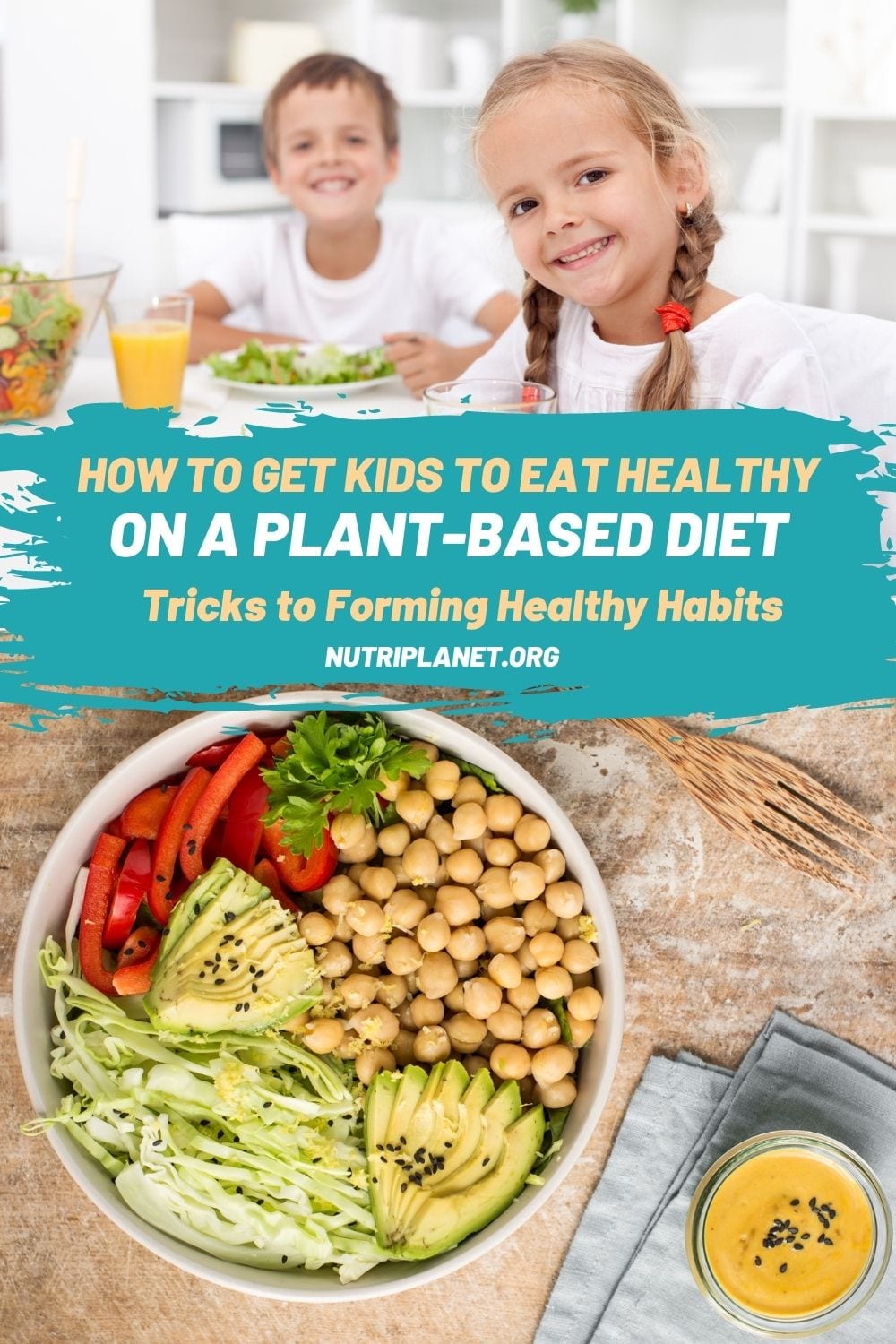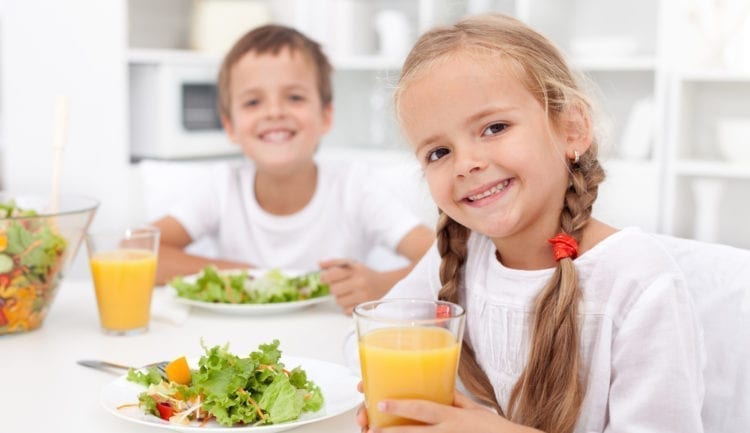Learn how to get kids to eat healthy on a plant-based diet and master your skills in forming healthy eating habits right from the start!
Since we’ve decided to be plant-based diet, our children will only benefit from our change to eating a whole foods diet. The easiest way to introduce kids to eating healthily is to start right from the beginning.
Your child starts with solid foods at about six-months old. This is the best time to introduce him/her to plant-based whole foods. My kid’s first food was broccoli and he still loves it today.
Download FREE Guide to Transitioning to Whole Food Plant-Based Diet
(including a full day’s meal plan)
We don’t strictly forbid our son to eat certain foods. Instead, we explain why some foods are beneficial and others aren’t. Our child was introduced to so many different kinds of foods at a young age that he developed a wide palate. Other parents are amazed when they see him eating with gusto something most kids hate, like baked eggplant, steamed spinach, chard or kale.
How to Get Kids to Eat Healthy
Be an example
Children will more likely act as you do: not do as you say. If they see you aren’t sticking to a plant-based whole-foods and are eating junk, then you can’t blame them for not getting on board with your eating plan.
We think it’s important to form your child’s palate and habits during the first three to five years of life. This way their base is strong enough so they can make sensible choices themselves. As this is the age kids imitate your behaviour the most, it’s also crucial to introduce proper table manners, enjoying your meal and time together as well as being thankful for the food.
My kid sometimes sits back in the middle of a meal, closes his eyes and steadily chews. Then he announces how yummy everything is and how much he enjoys the food.
How to deal with candy-throwing grandparents
Grandparents love giving their grandchildren treats. Instead of handing out processed sugar sweets, ask grandma or grandpa to give your kids fruits, berries and homemade sugar-free treats. Kids love these just as much although sometimes the grandparents will need some coaxing to make the change.
In the end, it’s about understanding the roots of traditions, not about the candy. It’s about the joy of giving a grandchild something and seeing his joy.
If your children have already formed certain eating habits, try introducing new foods to them. Grow (if possible), buy, wash, peel and cook together and tell them how fascinating and beautiful the plant based or fruit based is and where it comes from.
My child grows (with grandma’s help of course) carrots, beets, peas, onions, salad etc. and is proud of his vegetables and seems uplifted when he eats them.
You don’t need acres of land to grow herbs and spices. City dwellers can use windowsills to raise small plants.
Let kids cook
One of the key factors of how to get kids to eat healthy is cooking together. Kids are much more likely to eat food if they’ve been involved in the cooking process. It’s something they’ve created themselves and they take pride in it. For example, my son often helps his daddy chop the fruits and veggies for the morning smoothies.
Let kids play with food!
Yes, you read that right. When children are introduced to unfamiliar foods, it’s important not to force them to eat it straight away. Let them explore how the vegetables look, feel, smell and finally, taste.
Play with them!
Make animals or other shapes/characters cut out of fruits and vegetables, i.e. faces, broccoli-spruce, animals like cauliflower-sheep. Search the web for inspiration and let your imagination grow.
Remember: don’t force your children or threaten them with punishment if they don’t taste or finish the food. The process has to be playful and the kids need to have fun. As a parent, remain calm and don’t be pushy so your children don’t develop negative associations with eating.
Focus on seasonal vegetables, as these always taste the best. For example, in summer squash season prepare it in different ways such as oven-baked, raw (grated), cut as spaghetti with sauce, in a stew, in a cake or muffins. Make sure there’s always something on the plate your child definitely likes too. Then make a deal with him/her to also taste the squash. They don’t need to like it, but they should at least taste it each time. If they still want to spit it out after 20 meals then you can officially give up and maybe try again after some time. Always make sure to have enough other food on the plate so your child won’t leave the table hungry. It’s also important not to prepare different meals for children just because they say they won’t eat new foods.
Often kids like to eat everything separately, i.e. they won’t touch stew, but they’ll eat all the same veggies separated on a plate.
Download FREE Guide to Transitioning to Whole Food Plant-Based Diet (including a full day’s meal plan)
Don’t have any refined foods, especially sweets, in your home
Another crucial component in the equation of how to get kids to eat healthy is to keep the temptations out of site. This way your kids won’t be tempted to eat the processed snacks. Make healthy treats at home that your kids can also take to school – like these carob candies.
Have heathy snacks available
Keep fruits and vegetables and other nutritious treats where your kids can easily reach them like on kitchen counters, on the table and in the fridge on the low shelf.
Cut raw veggies (carrots, bell pepper, cauliflower, cucumber), make a dip (hummus, nut cream), put out fruits (apples, pears, bananas, oranges etc.), and nuts so your kids can have them when they’re hungry.
Never give your children the impression you’re desperately trying to feed them vegetables. Instead, prepare a dish or tray and let them know it’s there for everybody. I know of children who refuse certain vegetables when offered, but when the tray is left in reach they’ll try (or even finish) it when no one’s looking.
Put a plate with apples, carrots etc. in bite-size chunks beside a teenager sitting behind computer and they won’t even notice they’ve finished the whole snack.
Again, always be an example. Grab a bite every time you pass the plate yourself.
Schools and kindergartens
How to get kids to eat healthy when they head off to class? The thing is, it may not be possible for them to get a balanced plant-based meal at school and kindergarten.
If you aren’t prepared to pack your child a lunchbox, try getting a dairy free menu for your child. If this isn’t possible, we’d very much recommend getting used to the lunchboxes.
When cooking dinner, make a little extra and put it in the fridge for your child’s meal the next day. Add some fresh veggies (carrots, cucumbers) and nuts for snacks.
For schoolchildren sandwiches with whole grain bread are a good option. Your kids can even prepare these themselves using ingredients they like.
I have been doing this for my son. The teachers in his kindergarten are helpful and heat up his lunch on a stovetop. Since this was his routine from the beginning, he has had no problems with having different food than other kids. On the contrary, they often want to taste whatever he’s having as his food is always colorful.
If there’s no possibility to heat up lunch, warm it up in the morning and use insulated containers to pack the food for the day.
Read more on Back-to-School Lunchboxes.
Download FREE Guide to Transitioning to Whole Food Plant-Based Diet (including a full day’s meal plan)
For handling birthdays and other social gatherings, see my Tips for Plant-Based Entertaining and Visiting. The main thing here is to bake something for your child to bring along so he/she can also have a sweet treat. Find a recipe under Plant-Based Desserts.
In the end, kids, especially smaller ones, are more interested in playing than eating. Another alternative is to have your meal before you go to a party.
Children raised on a whole-food plant diet have formed healthy habits growing up and don’t have to make a major change to either lose weight or treat an illness when they’re grown up.

This post is also available in: Spanish











